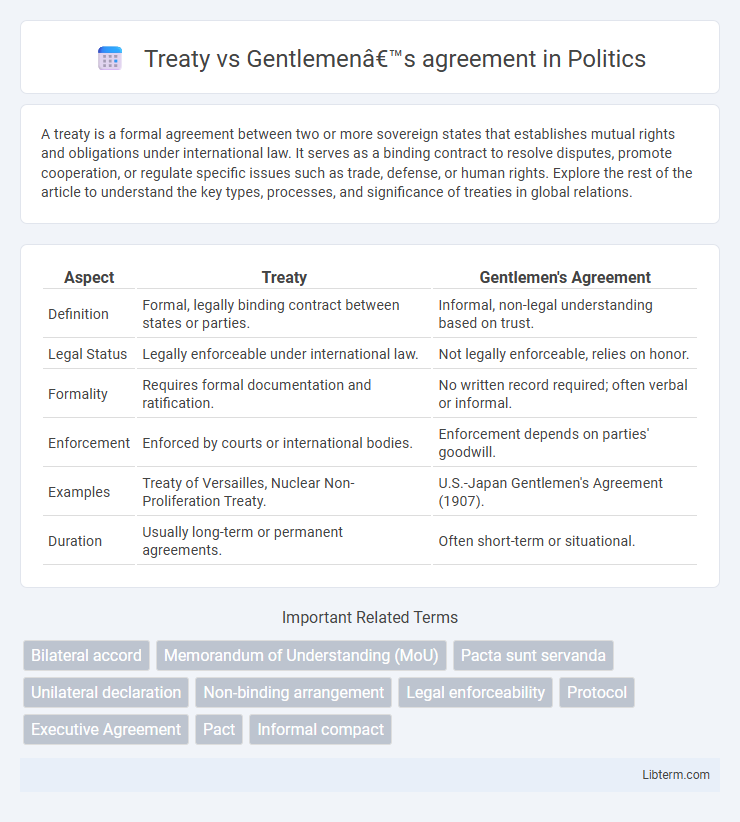A treaty is a formal agreement between two or more sovereign states that establishes mutual rights and obligations under international law. It serves as a binding contract to resolve disputes, promote cooperation, or regulate specific issues such as trade, defense, or human rights. Explore the rest of the article to understand the key types, processes, and significance of treaties in global relations.
Table of Comparison
| Aspect | Treaty | Gentlemen's Agreement |
|---|---|---|
| Definition | Formal, legally binding contract between states or parties. | Informal, non-legal understanding based on trust. |
| Legal Status | Legally enforceable under international law. | Not legally enforceable, relies on honor. |
| Formality | Requires formal documentation and ratification. | No written record required; often verbal or informal. |
| Enforcement | Enforced by courts or international bodies. | Enforcement depends on parties' goodwill. |
| Examples | Treaty of Versailles, Nuclear Non-Proliferation Treaty. | U.S.-Japan Gentlemen's Agreement (1907). |
| Duration | Usually long-term or permanent agreements. | Often short-term or situational. |
Introduction to Treaties and Gentlemen’s Agreements
Treaties are formal, legally binding agreements between sovereign states governed by international law, often requiring ratification by legislative bodies. Gentlemen's agreements are informal, non-binding understandings based on trust and honor, typically lacking legal enforceability and formal documentation. Both serve as diplomatic tools, but treaties carry legal obligations while gentlemen's agreements rely on mutual goodwill.
Defining Treaties
Treaties are formal, legally binding agreements between countries, established under international law and often requiring ratification by each state's legislative body. These binding contracts clearly outline the rights and obligations of the parties involved and are enforceable in international courts. Unlike informal gentlemen's agreements, treaties offer a structured framework with official documentation and legal authority.
Defining Gentlemen’s Agreements
Gentlemen's agreements are informal, non-legally binding arrangements based on trust and honor between parties, unlike treaties which are formal, legally enforceable contracts typically between states. These agreements rely on the integrity and goodwill of involved parties rather than written documentation or legal enforcement mechanisms. Gentlemen's agreements often serve as flexible, pragmatic solutions in diplomacy and business when formal treaties are impractical or unnecessary.
Key Legal Differences
A treaty is a formal, legally binding agreement between sovereign states that must be ratified through established constitutional processes, while a gentlemen's agreement is an informal, non-binding understanding based on trust and goodwill without legal enforcement mechanisms. Treaties are subject to international law and can be enforced through international courts or sanctions, whereas gentlemen's agreements rely solely on the parties' voluntary compliance. The ambiguity and flexibility of gentlemen's agreements contrast sharply with the explicit legal obligations and formal documentation of treaties.
Binding Nature and Enforcement
A treaty is a formally ratified international agreement that is legally binding and enforceable under international law, often involving explicit obligations and mechanisms for dispute resolution. A gentlemen's agreement, by contrast, is an informal, non-binding understanding based on trust and mutual consent without legal enforcement or formal ratification. The binding nature of treaties ensures accountability and compliance through recognized legal frameworks, while gentlemen's agreements rely solely on goodwill and diplomatic pressure.
Examples in International Relations
The Treaty of Versailles (1919) exemplifies a formal, legally binding international agreement that reshaped post-World War I geopolitics by imposing reparations on Germany. In contrast, the Gentlemen's Agreement between the United States and Japan (1907-1908) reflects an informal, non-legally binding understanding to restrict Japanese immigration without formal treaties. While treaties like the Nuclear Non-Proliferation Treaty (NPT) create codified commitments among states, gentlemen's agreements often rely on trust and political goodwill, such as the U.S.-UK informal cooperation prior to World War II.
Advantages of Treaties
Treaties provide legally binding commitments between states, ensuring clarity and enforceability in international relations. They establish formal frameworks for cooperation, dispute resolution, and accountability, enhancing predictability and stability in diplomatic interactions. Unlike gentlemen's agreements, treaties are registered with the United Nations, increasing transparency and international oversight.
Advantages of Gentlemen’s Agreements
Gentlemen's agreements offer advantages such as flexibility and speed, allowing parties to reach understanding without the need for formal ratification processes or lengthy negotiations. These informal accords foster trust and cooperation, enabling adjustments and adaptations as circumstances evolve without legal constraints. Their non-binding nature reduces diplomatic tensions and facilitates discreet problem-solving between parties.
Potential Risks and Limitations
Treaties involve formal, legally binding obligations between states, reducing ambiguity and providing clear enforcement mechanisms, whereas gentlemen's agreements rely on mutual trust without legal enforceability, increasing the risk of non-compliance. The limitations of gentlemen's agreements include vulnerability to changing political climates and lack of transparency, which can lead to misunderstandings or disputes. Treaties face potential risks such as lengthy negotiation processes and possible non-ratification, but they offer stronger stability and predictability in international relations.
Choosing Between a Treaty and a Gentlemen’s Agreement
Choosing between a treaty and a gentlemen's agreement depends on the desired level of legal enforceability and formality in international relations. Treaties are legally binding, formal documents registered with international bodies such as the United Nations, ensuring accountability and clear dispute resolution mechanisms. Gentlemen's agreements rely on mutual trust and political goodwill without legal obligations, making them suitable for flexible, less formal cooperation where rapid consensus is needed.
Treaty Infographic

 libterm.com
libterm.com